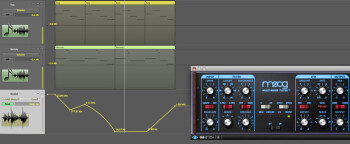After addressing the "whys" of automation last week it's only logical that we start looking into the "hows" this week.
However, since yours truly already dedicated an article to that subject around three years ago, I prefer to focus on one of the preceding topics: functional automation.
Once upon a time…
As I’ll explain shortly, the goal of this type of automation can be described as the fine-tuning of all the work you’ve done so far. I’ll show you two examples so you can understand better what I’m talking about. Do bear in mind that they are not exhaustive by any means, since there are so many different cases that it would absurd to try to cover all of them in such a short space.
For the first case study of functional automation, imagine you have a bass line with a fat low end and a rhythm jumbo folk guitar. If you follow the recommendations on EQing, chances are you have a filter (low-pass or shelving) on the guitar, in order to leave some space to the bass in the low end of the spectrum. This makes it easier to make the bass and guitar fit better together and is the best way to go most of the times… But what happens when the guitar is playing on its own, like on the intro or during a break? The guitar might sound too “thin” and quite unnatural. That’s exactly the moment when it might prove necessary to automate the filter, so the guitar sounds rounder, making the overall result more balanced or “full.” But you need to be careful! The automation must go unperceived to the listener. There’s nothing more annoying for the latter than to have hear everything your hands are doing behind the scenes. Unless, of course, it’s meant as a special production effect contributing to the climatic evolution of the song, which falls outside the scope of today’s article.
For the second example of functional automation I’ll use compression. Imagine an instrument whose dynamics you control with a compressor inserted in the track. It works pretty smoothly throughout the entire song, except for a couple of parts where the musician gets carried away by the performance, producing some peaks that make the plug-in be too audible and/or unaesthetic. What can you do? Well, there are several solutions. First, you could automate the threshold level of the compressor during the peaks so that the latter can absorb better the excess of zeal of the musician. Or you could automate the volume of the track during the parts in question, before the signal goes into the compressor. Do note that if your DAW doesn’t offer the possibility to adjust this parameter you can always insert a gain plug-in before the compressor to achieve the same result. In the end, all these options ought to make the compression evolve transparently across the entire song.
And that’s it for today. I hope these two examples make clear what functional automation is about. To sum it up, you could say that it’s a resource you can always resort to whenever your sonic puzzle needs a little help to sound more natural as your song evolves in time.

